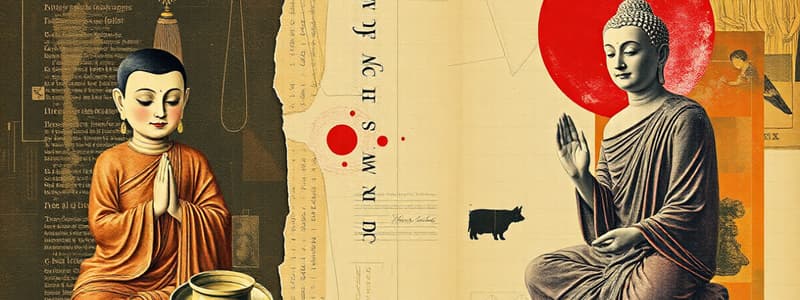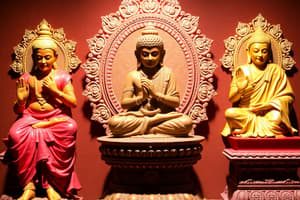Podcast
Questions and Answers
What was a primary factor that led to the rise of new religious ideas in the 6th century BCE?
What was a primary factor that led to the rise of new religious ideas in the 6th century BCE?
- The decline in the economic power of the Vaishya class.
- The rigid nature of the caste system and its associated social inequalities. (correct)
- The simplification of religious rituals and ceremonies.
- The increased availability of Sanskrit texts to the common people.
Which social class in the 6th century BCE were primarily responsible for the protection of people?
Which social class in the 6th century BCE were primarily responsible for the protection of people?
- Brahmins
- Shudras
- Vaishyas
- Kshatriyas (correct)
Why did the elaborate and expensive rituals performed by Brahmins become a point of contention in the 6th century BCE?
Why did the elaborate and expensive rituals performed by Brahmins become a point of contention in the 6th century BCE?
- Because they were costly for common people and had an adverse impact on agriculture. (correct)
- Because they were affordable to all social classes
- Because they promoted greater social equality.
- Because they were performed in Pali and Prakrit.
What language were the religious texts and hymns primarily composed in during the Later Vedic Age?
What language were the religious texts and hymns primarily composed in during the Later Vedic Age?
What encouraged individuals to question traditional Vedic rituals and practices?
What encouraged individuals to question traditional Vedic rituals and practices?
Two religious streams that posed a serious threat to the Vedic religion were Jainism and ______.
Two religious streams that posed a serious threat to the Vedic religion were Jainism and ______.
The social class that claimed the supreme position in the rigid caste system were the ______.
The social class that claimed the supreme position in the rigid caste system were the ______.
The ______, though wealthy, resented the superior position of the Brahmins.
The ______, though wealthy, resented the superior position of the Brahmins.
The common people wanted a simple religion explained in either Pali or ______.
The common people wanted a simple religion explained in either Pali or ______.
Wandering ascetics like Mahavira and the Buddha encouraged people to question established ______.
Wandering ascetics like Mahavira and the Buddha encouraged people to question established ______.
What was the social standing of the Vaishyas in the 6th century BCE in relation to their economic status?
What was the social standing of the Vaishyas in the 6th century BCE in relation to their economic status?
Besides Brahmins, which social class resented the social hierarchy in the 6th century BCE?
Besides Brahmins, which social class resented the social hierarchy in the 6th century BCE?
What were the Shudras forced to do, due to their low social status?
What were the Shudras forced to do, due to their low social status?
Why did animal sacrifices become a growing issue for agriculture in the 6th century BCE?
Why did animal sacrifices become a growing issue for agriculture in the 6th century BCE?
What role did the Upanishads play in the changing religious ideas of the 6th century BCE?
What role did the Upanishads play in the changing religious ideas of the 6th century BCE?
Flashcards
Rise of New Religious Ideas in Later Vedic Age
Rise of New Religious Ideas in Later Vedic Age
At the end of the Later Vedic Age, a new religious movement emerged, challenging the existing Vedic Religion. This movement saw the rise of new religious ideas and practices.
Rigid Caste System in 6th Century BCE
Rigid Caste System in 6th Century BCE
During the 6th century BCE, societal divisions and inequalities became deeply entrenched. The Brahmin class, the priests and scholars, enjoyed the highest status, while other social groups like Kshatriyas, Vaishyas, and Shudras faced significant restrictions and discrimination.
Complex and Expensive Vedic Rituals
Complex and Expensive Vedic Rituals
The Vedic rituals were elaborate and expensive, requiring priests (Brahmins) to conduct them. This placed a financial burden on common people and led to resentment towards the Brahmins.
Language Barrier in Vedic Religion
Language Barrier in Vedic Religion
Signup and view all the flashcards
Questioning Traditional Order
Questioning Traditional Order
Signup and view all the flashcards
Expensive Vedic Rituals
Expensive Vedic Rituals
Signup and view all the flashcards
Questioning the Traditional Order
Questioning the Traditional Order
Signup and view all the flashcards
Reasons for New Religious Ideas in 6th Century BCE
Reasons for New Religious Ideas in 6th Century BCE
Signup and view all the flashcards
What problem did the caste system create in 6th Century BCE?
What problem did the caste system create in 6th Century BCE?
Signup and view all the flashcards
Why did the Vedic rituals cause dissatisfaction among people in 6th Century BCE?
Why did the Vedic rituals cause dissatisfaction among people in 6th Century BCE?
Signup and view all the flashcards
What language barriers were present in Vedic religion?
What language barriers were present in Vedic religion?
Signup and view all the flashcards
How did the Upanishads and wandering ascetics influence religious change?
How did the Upanishads and wandering ascetics influence religious change?
Signup and view all the flashcards
What factors encouraged the growth of new religious ideas in 6th Century BCE?
What factors encouraged the growth of new religious ideas in 6th Century BCE?
Signup and view all the flashcards
Study Notes
Jainism and Buddhism: Overview
- New religious movements emerged at the end of the Later Vedic Age, challenging the Vedic religion.
- Jainism and Buddhism were prominent among these movements, growing in strength and posing a threat to Vedic religion.
Reasons for the Growth of New Religious Ideas (6th Century BCE)
- Rigid Caste System: The caste system became rigid, with Brahmins holding a dominant position. This generated resentment among Kshatriyas, Vaishyas, and Shudras. Shudras faced significant restrictions, including exclusion from temples and water sources.
- Complex and Expensive Rituals: Elaborate Hindu ceremonies, sacrifices, and rituals were costly and inaccessible to commoners. Animal sacrifices were increasingly problematic for agriculture and trade as animals were crucial for these activities.
- Language Barrier: Religious texts were in Sanskrit, making them inaccessible to people who spoke Prakrit or Pali.
- Upanishads and wandering ascetics (like Mahavira and Buddha) fostered questioning of Vedic traditions and rituals.
Jainism
- Jainism is based on the teachings of Tirthankaras, with Mahavira being the 24th and most prominent.
- Mahavira (Vardhamana): Born in 6th century BCE Vaishali, became a monk at 30, preached for 30 years, and died in Pava. Known as the "conqueror of the self".
- Core Teachings:
- Ahimsa (non-violence): Respect for all living and non-living things; causing deliberate harm, even to an ant, was considered a sin.
- Moksha (salvation): Attaining liberation from the cycle of birth and rebirth through "right belief, right knowledge, and right action" (triratnas).
- Equality: Rejected the caste system.
- Opposed expensive Vedic rituals.
- Two Sects: Digambaras (sky-clad, no clothes) and Svetambaras (white-clad).
- Spread: Monks (munis) traveled throughout India, spreading teachings that were compiled into 46 texts (Agamas). Monks practiced extreme self-discipline, including covering mouths to prevent insect harm and sweeping paths before walking.
- Mahavira spoke in Prakrit, the language of the common people, not Sanskrit.
Buddhism
- Gautama Buddha (Siddhartha Gautama): Born in Lumbini (Nepal) in 563 BCE.
- Early Life: Raised in luxury, shielded from suffering. Witnessing suffering led him to abandon his privileged life in search of an end to suffering.
- Enlightenment: After abandoning asceticism, achieved enlightenment under a Bodhi tree at Bodh Gaya.
- Teachings:
- Four Noble Truths: Life is suffering; suffering arises from desire; suffering ceases when desire ceases; the Eightfold Path leads to the cessation of desire and Nirvana.
- Eightfold Path: Right view, thought, speech, action, livelihood, effort, mindfulness, and concentration to end suffering.
- Middle Path: Avoid extremes of self-mortification and indulgence.
- Ahimsa (non-violence).
- Rejected elaborate Vedic rituals.
- Rejected the caste system.
- Spread: Preached for 40 years, died at Kusinagar (Uttar Pradesh) in 483 BCE. Teachings organized into the Tripitakas (Sutra, Vinaya, Abhidharma).
- Two Sects: Mahayana (idol worship) and Hinayana (no idol worship).
- Spread: Monks (Bhikshus) and the monastic order (Sangha) propagated teachings in India and beyond (Central Asia, China, Southeast Asia).
- Patronage: Mauryan emperor Ashoka, and Kushan ruler Kanishka.
- Monasteries and Stupas: Built for monks and to preserve relics; centers of learning (e.g., Sarnath, Nalanda, Taxila).
- Jataka Tales: Stories about Buddha's previous lives.
- Buddha's teachings emphasized the four noble truths and a life of moderation and spoke in Prakrit to common people.
- Buddhism's decline in India was attributed to later Hindu reform and Gupta patronage, difficulties following teachings, and the Hun invasions.
Jainism and Buddhism: Comparison
- Similarities: Reform movements, influenced by Upanishads, rejected Vedas, promoted equality, opposed rituals, advocated for Nirvana, ahimsa, and community living, mostly using Prakrit.
- Differences: Jainism emphasized asceticism and an eternal soul; Buddhism emphasized the Middle Path and denied an eternal soul. Jainism maintained primarily in India, whereas Buddhism spread widely.
Ahimsa
- A core concept preached by both Mahavira and Buddha.
- A powerful tool for conflict resolution. Important in maintaining peace and harmony, further emphasized by Mahatma Gandhi.
- Relevant today for nonviolent conflict resolution.
Studying That Suits You
Use AI to generate personalized quizzes and flashcards to suit your learning preferences.




